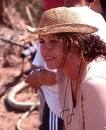Adalberto Giovannini
Helike *
Helike (pronounced he-LEEK-ee) was an ancient Greek city in Achaea, which was submerged by an earthquake and accompanying tidal wave in the winter of 373 BC.Strabo describes Helike as being 12 stades distant from the sea (geog.8.7.2)(g). The same event also destroyed the city of Boura located southeast of Helike(h).
tidal wave in the winter of 373 BC.Strabo describes Helike as being 12 stades distant from the sea (geog.8.7.2)(g). The same event also destroyed the city of Boura located southeast of Helike(h).
In 1988 the Greek archaeologist Dr. Dora Katsonopoulou and Dr. Steven Soter established the Helike Project(a) with the aim of locating the lost city. Katsonopoulou grew up just a few miles from the Helike site and would have been fully aware of any local stories regarding its destruction. It took until 2001 before their excavations were successful. Fortunately, a BBC Horizon team was on hand to record the event and have made a transcript of the transmission available on the Internet(b). The work has continued every year since then. It is worth noting that during the excavation of the town, an even earlier Bronze Age settlement was unearthed nearby that may have greater significance than Helike itself.
The Helike/Boura disaster took place just a few years before Plato wrote his Timaeus and Critias dialogues, which are believed to be among his last compositions, dated 355-347 BC(c). Frank Joseph erroneously claims that Plato could not have been influenced by the Helike disaster, because according to Joseph the Atlantis dialogues were written 25 years before the obliteration of Helike [1074.14]. Coincidentally, there was another Greek inundation following an earthquake during Plato’s lifetime at a place with the evocative name of Atalanta!
 One suggestion is that Plato had been aware of Solon’s story for some time but with the dramatic destruction of Helike he found that the story of the destruction of Atlantis would be more credible if given a similar demise.
One suggestion is that Plato had been aware of Solon’s story for some time but with the dramatic destruction of Helike he found that the story of the destruction of Atlantis would be more credible if given a similar demise.
Katsonopoulou contends that this disaster was the inspiration for Plato’s story of the destruction of Atlantis and presented a paper to the 2005 Atlantis Conference [629.327], outlining her views. Although she is seen as the champion of the Helike-Atlantis theory she was not the first to suggest a possible connection.
The British philosopher A.E. Taylor (1869-1945) was probably the first, in 1928, to consider the destruction Helike as a template for the demise of Plato’s Atlantis[638]. This idea was endorsed(f) a couple of years later by the French writer Perceval Frutiger[639] and in the 1980s, Professor Adalberto Giovannini(d), a Swiss historian as well as Phyllis Young Forsyth both viewed the Helike event as having had some influence on Plato’s narrative of the Atlantis story.
(b) https://www.bbc.co.uk/science/horizon/2001/helike.shtml
(c) https://web.archive.org/web/20240627222643/https://iep.utm.edu/plato/
https://web.archive.org/web/20240627222643/https://iep.utm.edu/plato/
(d) https://historyandsoon.wordpress.com/2015/10/22/uncovering-the-lost-city-of-helike/
(e) THE ATLANTIS HYPOTHESIS: Searching for a Lost Land, International Conference Atlantis 2005, 11 – 13 July 2005, Milos Island, Greece,Atlantis milos: Abstracts (archive.org) (abstract only)
(f) http://www.geoprobe.org/helike/atlantis.html
(g) Strabo, Geography, Book 8, chapter 7, section 2 (tufts.edu)
(h) https://en.wikipedia.org/wiki/Bura_(Achaea)
